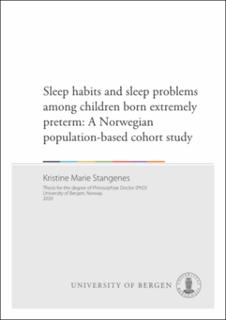| dc.contributor.author | Stangenes, Kristine Marie | en_US |
| dc.date.accessioned | 2020-10-02T07:01:58Z | |
| dc.date.available | 2020-10-02T07:01:58Z | |
| dc.date.issued | 2020-10-09 | |
| dc.date.submitted | 2020-09-23T07:00:46.935Z | |
| dc.identifier | container/d4/85/10/f6/d48510f6-deda-486c-9a58-14aec1d8e0c8 | |
| dc.identifier.isbn | 9788230847787 | en_US |
| dc.identifier.isbn | 9788230850602 | en_US |
| dc.identifier.uri | https://hdl.handle.net/1956/24104 | |
| dc.description.abstract | Objective: The objective of this thesis was to investigate the prevalence of general and specified sleep problems during childhood and the sleep habits of children aged 11 years who had been born extremely preterm (EPT). Furthermore, the study aimed to explore possible associations between sleep characteristics and neurodevelopmental disabilities (NDD), prenatal and neonatal factors, behaviour and respiratory health. Methods: A national cohort of all EPT children (gestational age [GA] < 28 weeks or birth weight< 1,000 g) born in Norway in 1999–2000 was investigated. In Paper 1, parental questionnaires mapped the children’s current sleep habits at 11 years of age and the prevalence of general and specified sleep problems throughout childhood up to this age. The prevalence of sleep problems throughout childhood and sleep habits at 11 years of age were compared with those of a control group. The EPT children were clinically assessed and given an NDD score at five years of age. In Papers 2 and 3, four current specified sleep problems, namely, difficulty falling asleep or frequent awakenings, snoring, daytime sleepiness and non-recommended sleep duration (<9 hours), were mapped at 11 years of age. These problems were further explored for possible associations with prenatal and neonatal factors, behaviour and respiratory health. Prenatal and neonatal data were collected by all Norway’s obstetric and paediatric departments. Behavioural problems were assessed by parents and teachers using the Strengths and Difficulties Questionnaire (SDQ). Parents assessed their children’s respiratory symptoms with the International Study of Asthma and Allergies in Childhood questionnaire and described the use of asthma medications. Results: In Paper 1, the study found that the EPT children had different sleep habits than the controls. They also had a higher prevalence of sleep problems than the controls throughout childhood (26% vs. 14%, odds ratio [OR] 2.1). This value was also higher for the EPT children with no NDD (20%) than for the controls (14%) and increased with increasing NDD. In Paper 2, the study found that smoking in pregnancy predicted snoring (OR 4.3), and neonatal cerebral haemorrhage and being born small for gestational age (SGA) predicted difficulty falling asleep or frequent awakenings (OR 2.2 and 2.3). Other morbidities during pregnancy or the newborn period or the burden of treatment in the neonatal intensive care unit did not predict specified sleep problems. In Paper 3, the study found that all four specified sleep problems, except for non-recommended sleep duration, were associated with higher parent-reported and teacher-reported SDQ total score (OR 1.1 for all). Daytime sleepiness was strongly associated with wheezing for the last 12 months, disturbed sleep due to wheezing, wheezing during or after exercise and use of asthma medications (OR 2.9 to 3.9). Snoring was associated with wheezing during or after exercise and current asthma (OR 2.8 and 4.2). Conclusion: EPT children are at increased risk of sleep problems in childhood. The prevalence of sleep problems increased with increasing NDD, but the EPT children with no NDD were also at increased risk compared with the controls. Of numerous prenatal and neonatal factors, only smoking during pregnancy, being born SGA and cerebral haemorrhage predicted specified sleep problems at 11 years of age. The EPT children with sleep problems had more behavioural and respiratory health problems compared with the EPT children without sleep problems. | en_US |
| dc.language.iso | eng | eng |
| dc.publisher | The University of Bergen | eng |
| dc.relation.haspart | Paper I: Stangenes KM, Fevang SK, Grundt J, Donkor HM, Markestad T, Hysing M, Elgen IB, Bjorvatn B. Children born extremely preterm had different sleeping habits at 11 years of age and more childhood sleep problems than term-born children. Acta Paediatrica. 2017 Dec;106(12):1966-1972. The article is available in the main thesis. The article is also available at: <a href="https://doi.org/10.1111/apa.13991" target="blank"> https://doi.org/10.1111/apa.13991</a> | en_US |
| dc.relation.haspart | Paper II: Stangenes KM, Hysing M, Fevang SK, Elgen IB, Halvorsen T, Markestad T, Bjorvatn B. Prenatal and neonatal factors predicting sleep problems in children born extremely preterm or with extremely low birthweight. Frontiers in Pediatrics. 2018 Jun 20;6:178. The article is available in the main thesis. The article is also available at: <a href=" https://doi.org/10.3389/fped.2018.00178" target="blank"> https://doi.org/10.3389/fped.2018.00178</a> | en_US |
| dc.relation.haspart | Paper III: Stangenes KM, Hysing M, Elgen IB, Halvorsen T, Markestad T, Bjorvatn B. Sleep problems, behavioural problems and respiratory health in children born extremely preterm: a parental questionnaire study BMJ Paediatrics Open. 2019 Sep 5;3(1):e000534. The article is available at: <a href="http://hdl.handle.net/1956/22632" target="blank">http://hdl.handle.net/1956/22632</a> | en_US |
| dc.rights | In copyright | eng |
| dc.rights.uri | http://rightsstatements.org/page/InC/1.0/ | eng |
| dc.title | Sleep habits and sleep problems among children born extremely preterm: A Norwegian population-based cohort study | en_US |
| dc.type | Doctoral thesis | |
| dc.date.updated | 2020-09-23T07:00:46.935Z | |
| dc.rights.holder | Copyright the Author. All rights reserved | |
| dc.contributor.orcid | https://orcid.org/0000-0002-1396-2829 | |
| fs.unitcode | 13-25-0 | |
